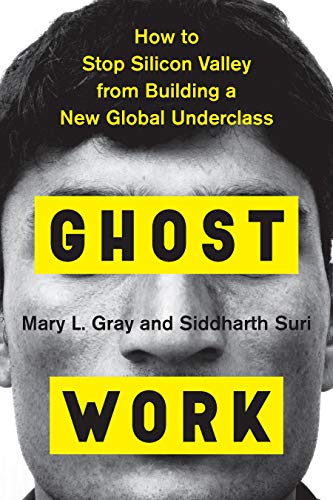Yes, There ARE Ghosts in the Machine
And one of them is youThe drumbeat is unrelenting: AI is coming, humans beware. Self-driving cars will save us from ourselves, AI will make decisions better we do, and—more recently—AI can be as creative as humans. But there is a dirty little secret underlying the hyped triumphs of AI: Humans.
Mary L. Gray is a Fellow at Harvard University’s Berkman Klein Center for Internet and Society. She is also a Senior Researcher at Microsoft Research. And she’s let AI’s secret out.
MIT Technology Review interviewed her recently about her new book, Ghost Work: How to Stop Silicon Valley from Building a New Global Underclass in which she looks into the lives of the hidden workers behind AI: “Human workers don’t just label the data that makes AI work. Sometimes humans workers are the artificial intelligence.” While Gray is most concerned (perhaps rightly) over their working conditions, her research also shows just how much the “human” powers AI.

The horrid working conditions of social media’s content moderators are not news:
The video depicts a man being murdered. Someone is stabbing him, dozens of times, while he screams and begs for his life. Chloe’s job is to tell the room whether this post should be removed. She knows that section 13 of the Facebook community standards prohibits videos that depict the murder of one or more people. When Chloe explains this to the class, she hears her voice shaking.
Returning to her seat, Chloe feels an overpowering urge to sob. Another trainee has gone up to review the next post, but Chloe cannot concentrate. She leaves the room, and begins to cry so hard that she has trouble breathing.
No one tries to comfort her. This is the job she was hired to do. And for the 1,000 people like Chloe moderating content for Facebook at the Phoenix site, and for 15,000 content reviewers around the world, today is just another day at the office.
Casey Newton, “The Trauma Floor” at The Verge
Less well-known is the fact that humans help Amazon’s Alexa to recognize speech. In China, huddled masses label images for self-driving cars. Social media giants also label content by human hand, including photos and status updates:
Facebook confirmed to Reuters that the content being examined by WiPro’s workers includes private posts shared to a select numbers of friends, and that the data sometimes includes users’ names and other sensitive information. Facebook says it has 200 such content-labeling projects worldwide, employing thousands of people in total.
James Vincent, “Facebook’s contract workers are looking at your private posts to train AI” at The Verge
You power AI too, whenever you prove your humanity to the CAPTCHA challenges overrunning the web.
A few times the secret has leaked because humans are not (always) easily fooled.
One sharp-eared waiter caught Duplex, Google’s reservation and appointment scheduling service, in the act. The waiter thought the Irish brogue sounded too good to be faked. He was right; the caller was human:
“It sounded very real,” Mr. Tran said in an interview after hanging up the call with Google. “It was perfectly human.”
Google later confirmed, to our disappointment, that the caller had been telling the truth: He was a person working in a call center. The company said that about 25 percent of calls placed through Duplex started with a human, and that about 15 percent of those that began with an automated system had a human intervene at some point.
Brian X. Chen and Cade Metz, “Google’s Duplex Uses A.I. to Mimic Humans (Sometimes)” at New York Times
Facebook admits that AI cannot function without the human input:
“It’s a core part of what you need,” Facebook’s Nipun Mathur, Director of Product Management for AI, told Reuters. “I don’t see the need going away.” Machine Learning, even if ill-named, is a marvel. It can help us at those points where we succumb to fatigue or information-overload. But it works only because humans have — through training and, sometimes, active engagement — helped it along. That’s what tools do: They magnify our skills and abilities; they do not replace them.
AI systems are not some alien brain evolving in our midst, soon to be our overlords and masters. They are machines we build and train by embedding our humanity into their programming.
So, let’s stop, or at least ignore, the hollow drumbeat of AI superiority. Humans are amazing and AI would be lost without them.
Also by Brendan Dixon: Could AI authentically create anything?
See also: Why I doubt that AI can match the human mind (Jonathan Bartlett)
